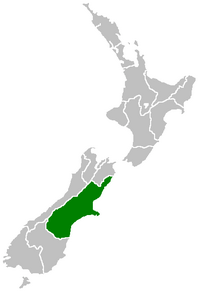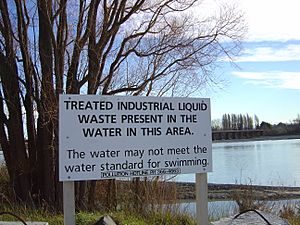Water pollution in Canterbury, New Zealand facts for kids

Water pollution in Canterbury, New Zealand has become a major environmental issue, largely due to pollution from agricultural sources, but also industrial and urban sources.
Water resources are under the jurisdiction of the Canterbury Regional Council (Environment Canterbury) under the Resource Management Act (RMA); water abstraction and use for irrigation purposes requires a resource consent.
The municipal water supply for Christchurch is sourced from the aquifers beneath the city.
Contents
Background
Due to the rain shadow effect of the Southern Alps the rainfall in Canterbury is lower than many other parts of the country at 500–700 mm per year. Water from melting snow and ice and from rainfall drain into the predominantly braided rivers on the Canterbury Plains. The rivers recharge the aquifers beneath the plains.
The Canterbury Region was traditionally arable and livestock farming but there have been a large number of dairy conversions in the region. In recent years there has been a huge expansion in dairy farming throughout the South Island. Dairy farming requires the intensive use of water and it is placing a high demand on water resources in the Canterbury Region.
Issues

The rivers and groundwater are being polluted with nitrates and E. coli and proposed irrigation schemes can increase the pollution levels. Nitrate concentrations in the groundwater are above the drinking water standards in some areas and elevated levels are widespread. Environment Canterbury's 2010 groundwater quality survey indicated that nitrate concentrations had increased in about one-third of the wells sampled during the past 10 years. Particularly of concern were the Selwyn, Ashburton and Orari-Opihi-Pareora areas. Of 322 wells sampled, 34 had concentrations of nitrate exceeding the maximum acceptable value for drinking-water standards.
Inorganic nutrients, an indication of water quality, are considered to be low but increase closer to the coast. For 2000-2001 28% of tested sites were classed as "alert" due to the presence of organic pollutants.
Water pollution of the two rivers flowing through the city of Christchurch, the Avon and the Heathcote, is of concern. Untreated sewage can flow into the rivers during times of high rainfall. The estuary where the two rivers discharge had received treated water from the sewerage treatment plant that processed the city's sewage. However, a pipeline was constructed to discharge the water into Pegasus Bay. It became operational in 2010.
The Central Plains Water scheme is a large-scale proposal for water diversion, damming, reticulation and irrigation over an area of 60,000 ha. Other proposed schemes will irrigate an addition 90,000 ha. A scheme to dam the Hurunui River to create water storage for irrigation attracted large scale opposition due in part to the possibility of increased water pollution. The resource consent application for the dams were put on hold.
A large number of resource consent applications for intensive dairy farming in the Mackenzie Basin attracted opposition due in part to the potential effects on water quality. The resource consents were called in under the RMA by the Minister for the Environment Nick Smith.
Cheviot has been on a boil water notice since October 2004.
Dunsandel had an untreated water supply but in 2009 E. coli was found in the 70 metre deep well that supplies the town. Effluent from dairy cows is suspected to be the cause of the pollution.
Mitigation
The Dairying and Clean Streams Accord was set up by Fonterra and a number of government agencies as a means of reducing nonpoint source pollution. The Accord is criticised for not achieving its goals.
Prosecutions
In recent years prosecutions have been made for causing water pollution:
- 2009 - Philip Curry was fined $5,000 after pleading guilty to discharging effluent onto land that may have resulted in contaminants entering nearby Barry's Bay Stream.
- 2009 - Corlette Holdings was fined $10,000 after pleading guilty to two charges of discharging effluent from an irrigator resulted in ponding and a second charge of effluent being discharged, which may have resulted in contaminated water.
- 2010 - A prosecution against Brook Farms and Mosbro Farms in Ashburton was withdrawn after they agreed to mitigate the effects of the effluent discharge.
- In 2012, Springston dairy farm company, White Gold Ltd, was fined a record $90,000 after illegally discharging 45,000 litres of diluted dairy effluent over a three-day period in 2010. The public reported the dairy effluent flowing into waterways that flowed into Lake Ellesmere.

